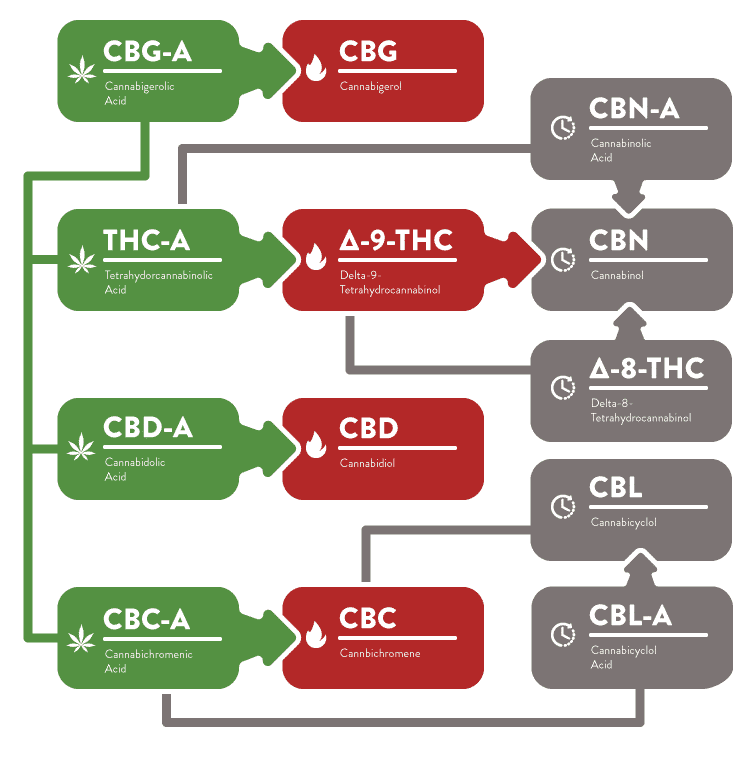This website requires you to be 21 years or older to enter. Please confirm your age below to continue.

Cannabis has been around for thousands of years and although scientists have been studying this amazing plant since the 19th century, we know very little about cannabinoids other than THC and CBD.
According to The Analytical Chemistry of Cannabis, this remarkable plant has over 500 compounds which include over 100 cannabinoids that have been identified. One of the cannabinoids making waves is cannabinol or CBN.
CBN was originally isolated from Indian cannabis red oil extracts in 1896, making it the first cannabinoid to be identified in cannabis. It was noted that this discovery was most likely due to rampant degradation of THC to CBN due to poor quality control, and the transportation and storage conditions related to the 19th century.
It was not until the 1930s that the structural determination by R.S. Cahn and total synthesis of CBN was carried out by R. Adams in 1940. For more than two decades after its discovery, the CBN cannabinoid was thought to be the principal psychoactive component of cannabis. Then, in 1964, Israeli researchers Yechiel Gaoni and Raphael Mechoulam effectively extracted THC from the cannabis plant and found its psychotropic effects. Further studies discovered CBN as the outcome of oxidized THC, but without the intoxicating properties of THC.
So What is CBN?
CBN is a cannabinoid found in the cannabis plant and is produced when THC degrades due to heat, air, light, or age. The concentration of CBN increases as the plant ages. As an example, let’s say 3 months ago you stashed away some cannabis and then forgot about it (it happens). Due to the aging time the THC has degraded or changed its structure and is now CBN.

CBN is mildly intoxicating (about one-fourth of the potency of THC) and has been labeled the sleeper cannabinoid by many. However, there are no studies confirming pure CBN is a sedative, but when CBN was given with THC, the combination was found to be very sedating.
Unlike THC, CBN binds mostly to the CB2 receptors in the body which are mostly found in the immune cells, which circulate throughout the body and brain via the bloodstream. They are also found in the spleen, bone and liver cells. CB2 receptors are only present in the brain when there is inflammation or injury. When inflammation occurs, CB2 activity inhibits inflammatory signaling pathways, bringing things back to a normal non-inflammatory state, or a state of homeostasis.
What are the benefits of CBN?
While there is not nearly as much research into CBN as there is for other cannabinoids, the limited evidence available suggests that CBN may have a number of health and wellness benefits.
Where Can I Find CBN?
Purchasing CBN at your local dispensary is one place you can start. Most dispensaries sell cannabinoids separately from cannabis flower or smoke. The product should be tested by a third-party laboratory for independent testing and have a certificate of analysis (COA) that outlines exact levels within the product, as well as the presents of any molds, pesticides and heavy metals.

If your local dispensary does not sell CBN you can “make” your own. Any flower can be converted over to CBN. You need to let it age. Note: timing will vary based on the stickiness and quality of the cannabis.
Keep in mind, that if you activate your own cannabis to make CBN it will still have some THC – which can make your CBN sedating.
Side effects
There are no known side effects of CBN – but that does not mean they don’t exist. CBN has not been studied as much as other cannabinoids like THC and CBD. As always, it is important to talk to your physician before adding any supplement to your current treatment.
Conclusion
Cannabinol (CBN) is a cannabinoid found in the cannabis plant. While there is a need for human research, early evidence shows great potential for this rare cannabinoid. CBN may be used effectively as a sleep aid or sedative. This cannabinoid has also been shown to help regulate the immune system and works to relieve the pain and inflammation caused by several conditions, including arthritis and Crohn’s disease. Studies show that it can be used to reduce the intraocular eye pressure caused by glaucoma. CBN acts as an anticonvulsant, so it is also beneficial to patients suffering from seizure disorders including epilepsy.
References
Corroon J. (2021). Cannabinol and Sleep: Separating Fact from Fiction. Cannabis and cannabinoid research, 6(5), 366–371. https://doi.org/10.1089/can.2021.0006
Filer, C.N. (2020). Minnesota wild hemp: A crucial botanical source in early cannabis discovery. J Cannabis Res, 2,25. https://doi.org/10.1186/s42238-020-00031-3
Karniol, I. G., Shirakawa, I., Takahashi, R. N., Knobel, E., & Musty, R. E. (1975). Effects of delta9-tetrahydrocannabinol and cannabinol in man. Pharmacology, 13(6), 502–512. https://doi.org/10.1159/000136944
Kogan, N. M., & Mechoulam, R. (2007). Cannabinoids in health and disease. Dialogues in clinical neuroscience, 9(4), 413–430. https://doi.org/10.31887/DCNS.2007.9.4/nkogan
Liang, Z., Soriano-Castell, D., Kepchia, D., et. al. (2022) Cannabinol inhibits oxytosis/ferroptsis by directly targeting mitochondria independently of cannabinoid receptors. Elsevier, 180, 33-51. https://doi.org/10.1016/j.freeradbiomed.2022.01.001
Pertwee R. G. (2006). Cannabinoid pharmacology: the first 66 years. British journal of pharmacology, 147 Suppl 1(Suppl 1), S163–S171. https://doi.org/10.1038/sj.bjp.0706406
Russo E. B. (2011). Taming THC: potential cannabis synergy and phytocannabinoid-terpenoid entourage effects. British journal of pharmacology, 163(7), 1344–1364. https://doi.org/10.1111/j.1476-5381.2011.01238.x
Somvanshi, R., ou, S., Kadhim, S., et. al. (2022). Cannabinol mosulates neuroprotection and intraocular pressure: A potential multi-target therapeutic intervention for glaucoma. Elsevier, 1868(3),166325. https://doi.org/10.1016/j.bbadis.2021.166325
Thomas, B., and ElSohly, M. (2016) The analytical chemistry of cannabis: The botany of cannabis sativa L. Elsevier, 1-26. https://doi.org/10.1016/B978-0-12-804646-3.00001-1
InMed Pharmaceuticals Announces Commencement of Phase 2 Clinical Trial Investigating Cannabinol (CBN), a Rare Cannabinoid, in the Treatment of Epidermolysis Bullosa. InMed Pharmaceuticals. Accessed 5/18/2022.
Walsh, K. B., McKinney, A. E., & Holmes, A. E. (2021). Minor Cannabinoids: Biosynthesis, Molecular Pharmacology and Potential Therapeutic Uses. Frontiers in pharmacology, 12, 777804. https://doi.org/10.3389/fphar.2021.777804
Weydt, P., Hong, S., Witting, A., Möller, T., Stella, N., & Kliot, M. (2005). Cannabinol delays symptom onset in SOD1 (G93A) transgenic mice without affecting survival. World Federation of Neurology, 6(3), 182–184. https://doi.org/10.1080/14660820510030149
Wong, H., & Cairns, B. E. (2019). Cannabidiol, cannabinol and their combinations act as peripheral analgesics in a rat model of myofascial pain. Archives of oral biology, 104, 33–39. https://doi.org/10.1016/j.archoralbio.2019.05.028
Zurier, R, and Burstein, S. (2016). Cannabinoids, inflammation, and fibrosis. FASEB Journal, 30(11),3682-3689. https://doi.org/10.1096/fj.201600646R